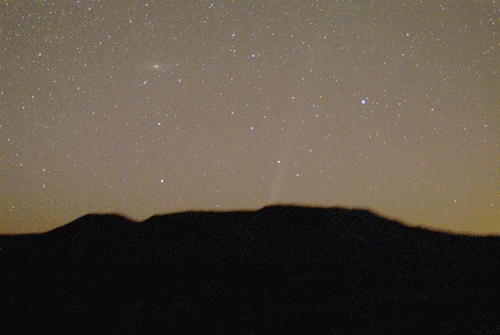
|
Credit & Copyright: Jimmy Westlake
(Colorado
Mountain College)
Explanation:
Comet Bradfield
has become quite a sight just before sunrise --
for those with binoculars or cameras.
Although fading noticeably each day, a
sky chart, a northern location, and some persistence
will allow curious sky gazers to locate the
cosmic snowball
and its
spectacular tail.
One might call Bradfield a "camera" comet as it's extended tail
is too long for most telescopes but caught nicely by normal cameras
capable of long exposures and set to
rotate with the sky.
Pictured above just yesterday,
Comet C/2004 F4 (Bradfield)
was caught as it rose on successive three-minute
exposures above the
Rocky Mountains near Yampa,
Colorado,
USA.
Visible on the upper left as a bright fuzzy smudge is the
Andromeda Galaxy (M31),
far in the distance.
Comet Bradfield was discovered only last month and was
briefly visible to the unaided eye.
It was imaged in
spectacular fashion by the
SOHO spacecraft as it
rounded the Sun early last week.
|
January February March April May June July August September October November December |
| ||||||||||||||||||||||||||||||||||||||||||||||||
NASA Web Site Statements, Warnings, and Disclaimers
NASA Official: Jay Norris. Specific rights apply.
A service of: LHEA at NASA / GSFC
& Michigan Tech. U.
Based on Astronomy Picture
Of the Day
Publications with keywords: comet - tail
Publications with words: comet - tail
See also:
- Comet C/2025 F2 SWAN
- APOD: 2025 February 5 Á Comet G3 ATLAS Setting over a Chilean Hill
- APOD: 2025 February 2 Á Comet G3 ATLAS Disintegrates
- APOD: 2025 January 28 Á Comet G3 ATLAS over Uruguay
- APOD: 2025 January 26 Á The Many Tails of Comet G3 ATLAS
- Comet G3 ATLAS: a Tail and a Telescope
- APOD: 2025 January 21 Á Comet ATLAS over Brasilia
